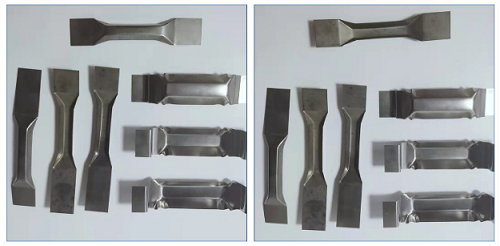Tungsten evaporation boats, made of 99.95% high-purity tungsten, withstand temperatures up to 3422℃ and are an irreplaceable core component in vacuum coating. Modern composite ceramic technology is breaking through its limitations, improving coating uniformity and stability.
Superior Characteristics and Applications of Tungsten Evaporation Boats
Tungsten evaporation boats (also known as coating tungsten boats) are core components in the vacuum coating industry, made from 99.95% pure tungsten sheets through welding or high-temperature stamping processes. This special vessel inherits the excellent properties of metallic tungsten: a density of 19.3 g/cm³, a melting point of 3422℃, and high strength, high hardness, and excellent wear resistance. In a vacuum environment, its low evaporation rate and low vapor pressure make it an ideal evaporation source material.
In terms of applications, tungsten evaporation boats are widely used in vacuum coating scenarios such as gold plating, cathode ray tube mirrors, electron beam painting, and semiconductor device manufacturing. Its superior high-temperature resistance (withstanding operating temperatures above 2000℃) and stable chemical properties make it stand out in vacuum annealing processes. It is particularly noteworthy that while modern high-performance ceramic composites (such as the boron nitride-titanium diboride system) have partially replaced traditional tungsten boats, tungsten evaporation boats remain the irreplaceable choice for applications requiring extremely high stability.
Modern evaporation boat technology is developing towards composite materials, addressing the limitations of traditional tungsten boats through material innovation. For example, boron nitride-titanium diboride composite ceramic materials retain the high-temperature characteristics of tungsten while improving thermal shock resistance. In terms of arrangement, staggered layouts are gradually replacing linear arrangements, allowing vapor clouds to support each other and significantly improving coating uniformity.
How to Select the Right Evaporation Boat and Crucible to Optimize the Coating Process
Coating Material Selection Properly selecting the evaporation boat and crucible during the coating process is a common and crucial issue. Evaporation boats, due to their simple structure and convenient operation, have become the most commonly used evaporation source. The available materials include tungsten, molybdenum, tantalum, and niobium, while conductive ceramic materials such as graphite and conductive boron nitride are also highly favored.
It is worth noting that tungsten, molybdenum, and tantalum may become brittle due to recrystallization at high temperatures, requiring careful selection. On the other hand, there are many types of crucibles, including tungsten crucibles, molybdenum crucibles, tantalum crucibles, copper crucibles, graphite crucibles, alumina crucibles, and conductive boron nitride crucibles. Selection requires comprehensive consideration based on specific materials and coating requirements.
Material Properties and Selection Considerations
In physical vapor deposition (PVD) processes, the evaporation boat is a core component, directly affecting coating quality and production efficiency. FOTMA evaporation boats are manufactured using high-performance refractory metals such as tungsten, molybdenum, lanthanum molybdenum (Ml), yttrium molybdenum oxide (MY), or tantalum. Specifically designed for resistance evaporation processes, they possess excellent thermal stability and material purity, and are widely used in high-end manufacturing fields such as electronics, optics, and decoration.
Key Role in Vacuum Evaporation Process
In the vacuum thermal evaporation process, the evaporation boat is heated by electricity to vaporize the coating material, forming a wear-resistant layer such as aluminum, silver, chromium, titanium nitride, or silicon dioxide. These coatings are widely used in the surface treatment of products such as watches, mirrors, and electronic components. Panshi’s evaporation boat, with its low vapor pressure and high dimensional stability, ensures that no metal particles penetrate into the final coating throughout the evaporation process, guaranteeing product quality.
Advantages of FOTMA Material:
* Ultra-high melting point: Materials such as tungsten and tantalum have extremely high melting points, suitable for extreme high-temperature environments.
* Low vapor pressure: Even at high temperatures, the evaporation boat material itself will not enter the deposited layer.
* Excellent corrosion resistance: Effectively extends service life and reduces replacement frequency.
* Good electrical conductivity: Ensures heating efficiency and temperature uniformity.
* High dimensional stability: Ensures coating uniformity and repeatability.
Multiple material and structure options:
Tungsten Evaporation Boat
Tungsten has an extremely high melting point and corrosion resistance, suitable for high-temperature evaporation environments. The dimensional stability of molybdenum is further enhanced by adding dopants such as potassium silicate.
Molybdenum Evaporation Boat: Molybdenum exhibits stability at high temperatures. Doping with lanthanum oxide (Ml) or yttrium oxide (MY) significantly improves its ductility and processability.
Tantalum Evaporation Boat: Tantalum has extremely low vapor pressure and a slow evaporation rate, but its exceptional corrosion resistance makes it ideal for processes requiring extremely high purity.
FOTMA provides a comprehensive material compatibility table to help customers select the most suitable evaporation boat model based on coating materials (such as aluminum, silver, gold, oxides, fluorides, etc.). For some materials, tungsten (W), molybdenum (Mo), or tantalum (Ta) evaporation boats are recommended to ensure the optimal balance between evaporation efficiency and coating quality.
FOTMA Advantages: End-to-End Control from Materials to Finished Products: As a leading global expert in refractory metals, FOTMA completes all processes from raw material refining to finished product processing in its own factories, ensuring product purity and consistency. We also offer complementary products such as molybdenum, tungsten, and tantalum crucible inserts and rotating filaments to meet diverse customer needs in electron beam evaporation and resistance evaporation.
If you are interested in FOTMA’s tungsten and molybdenum products, please contact us!
Post time: Nov-27-2025


